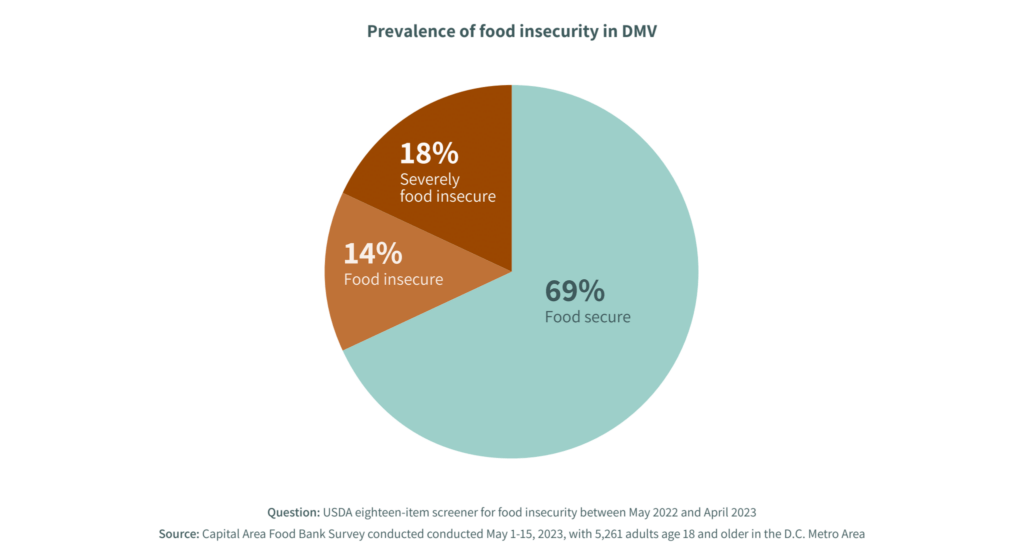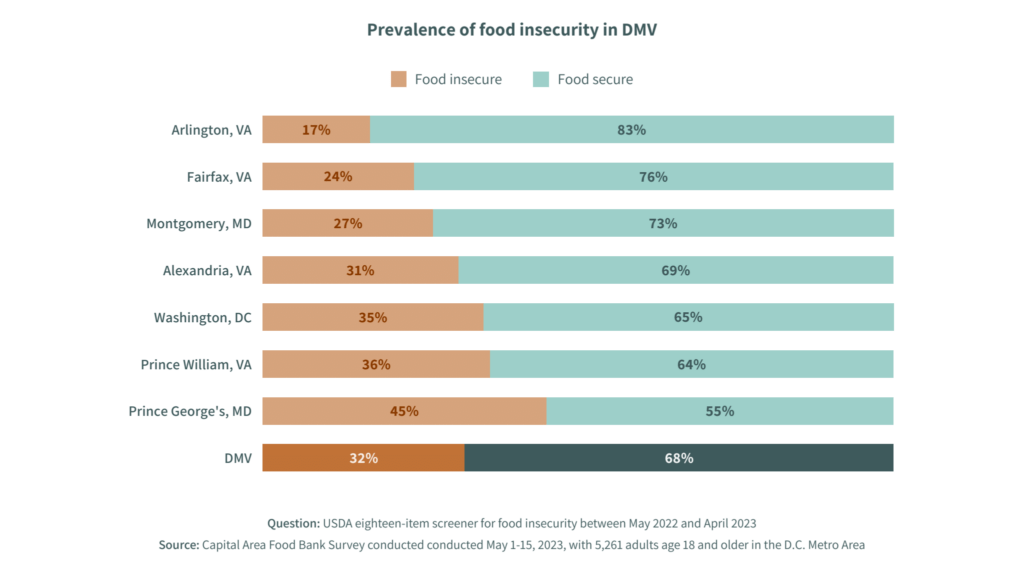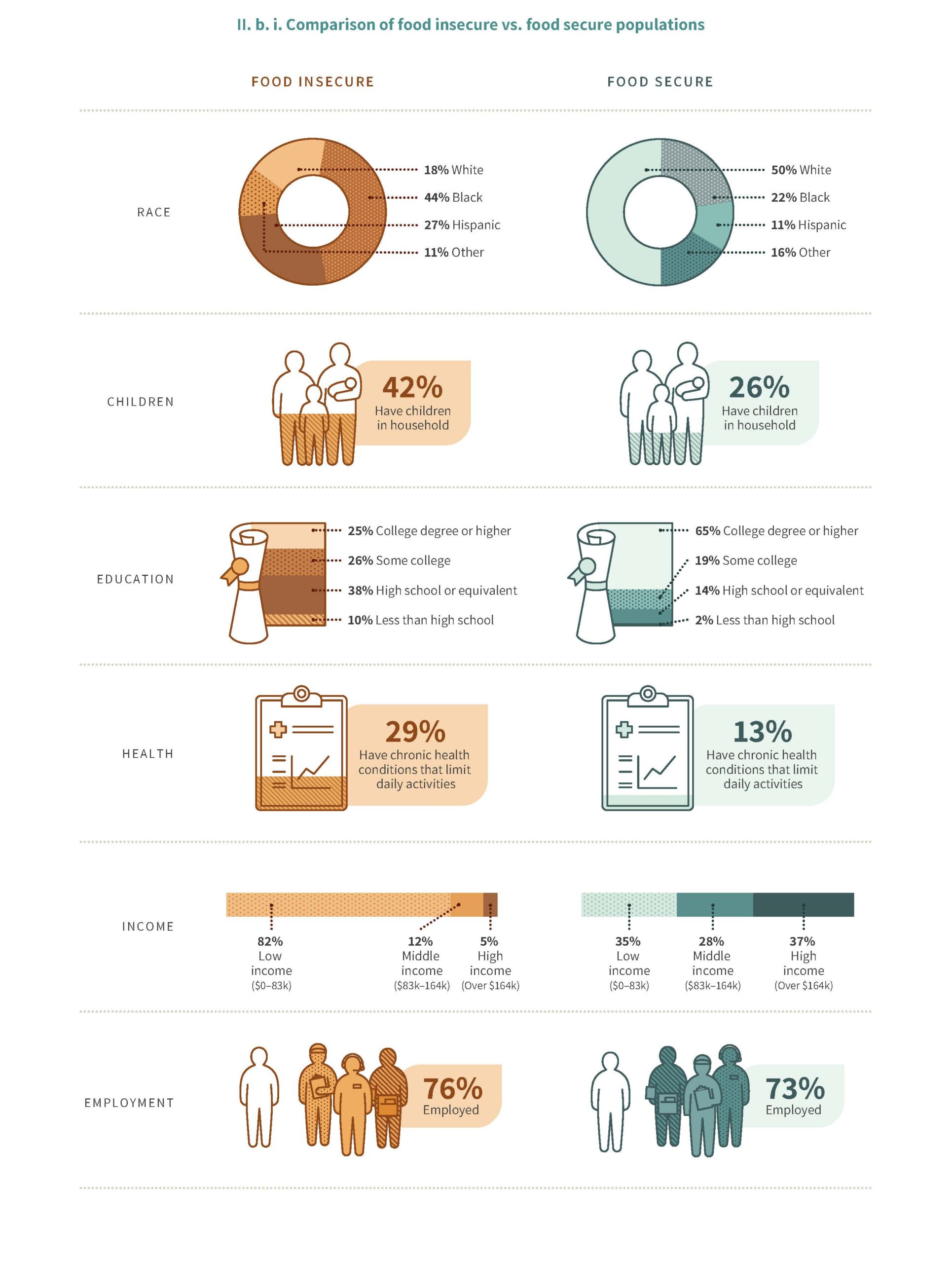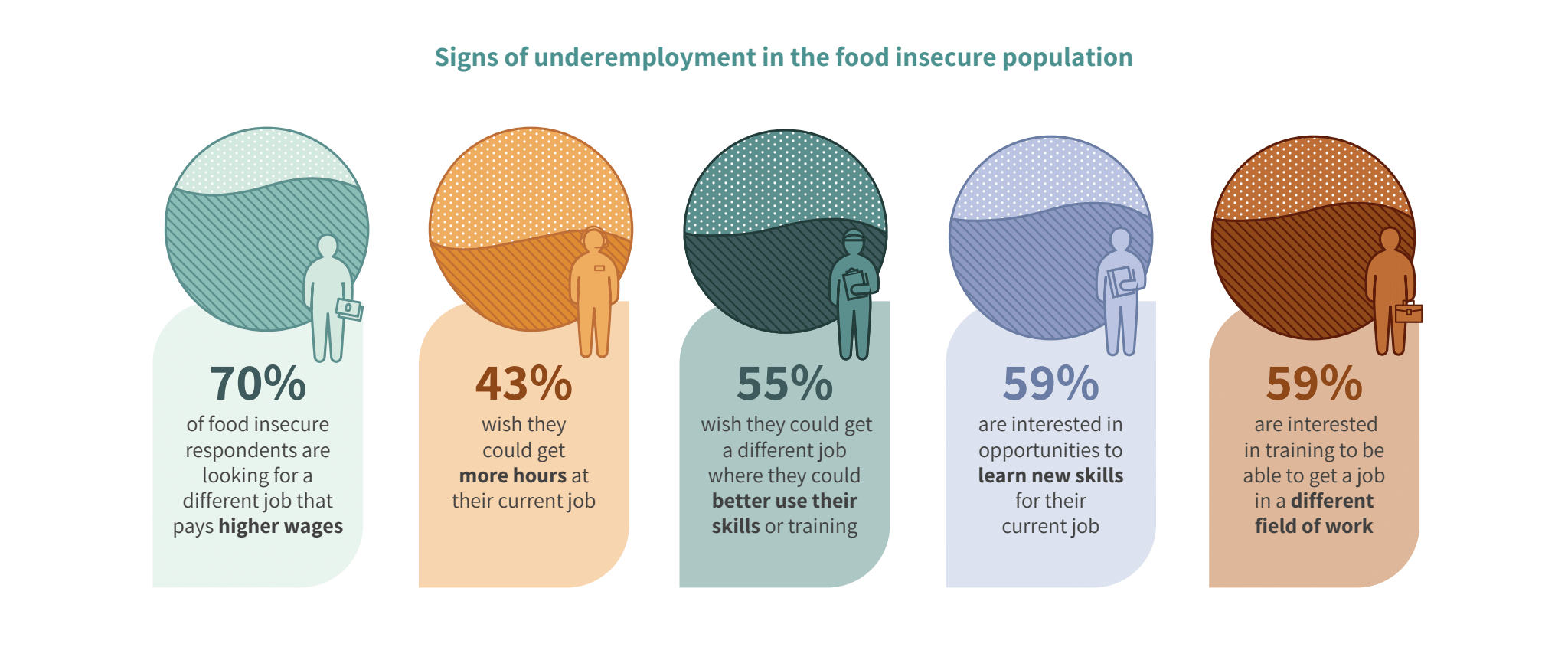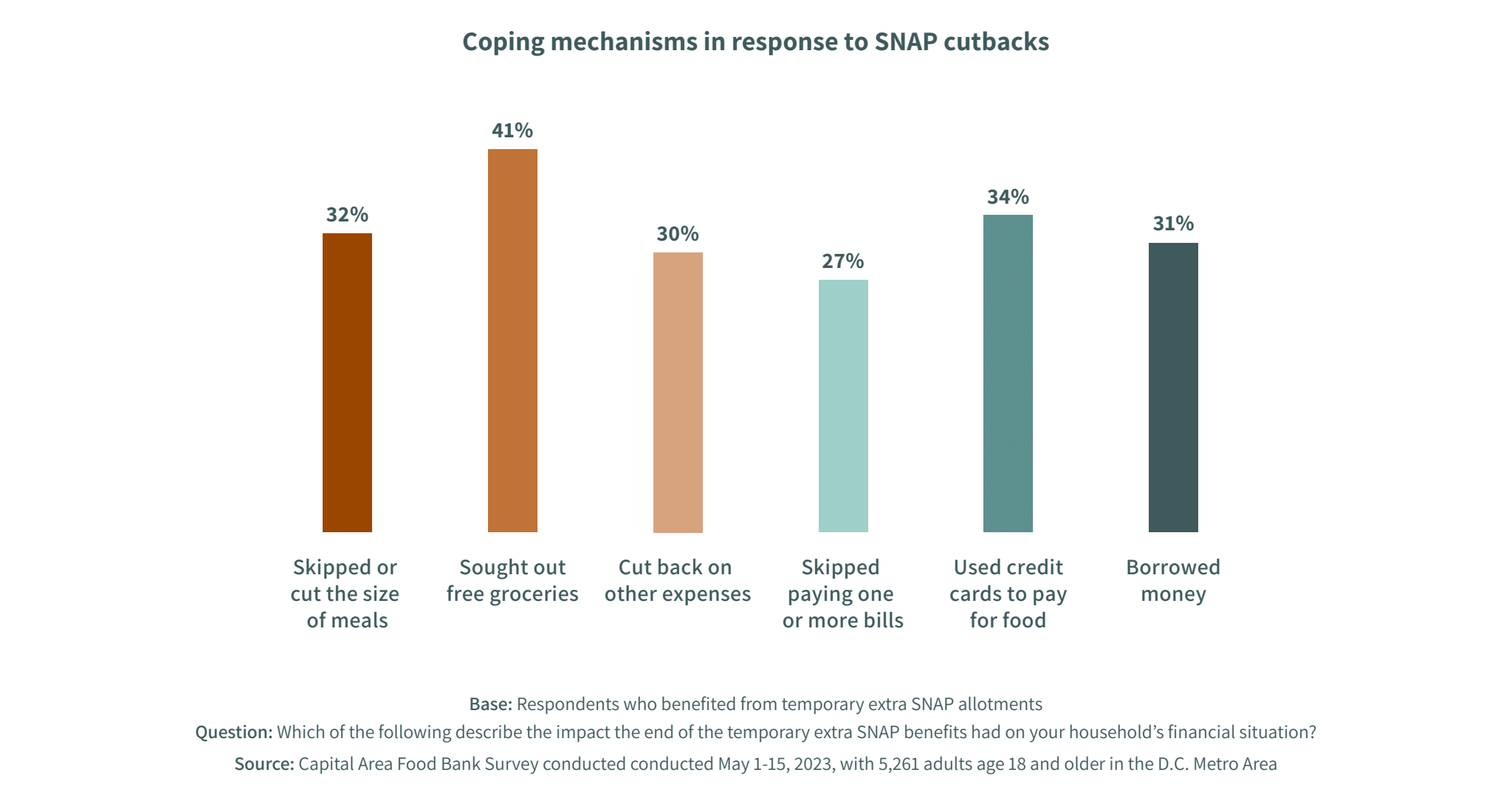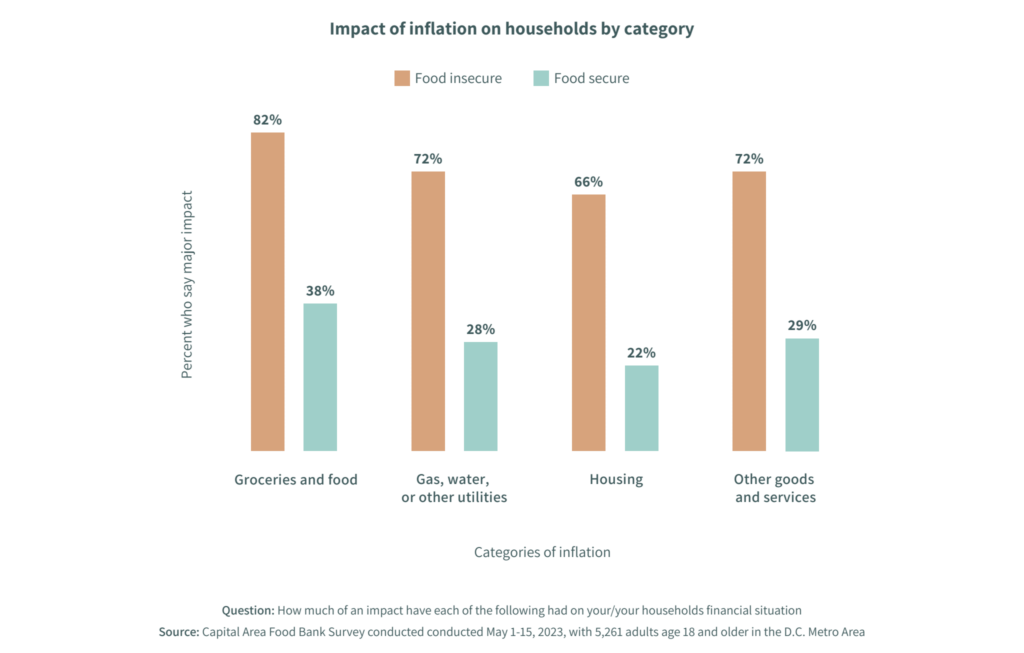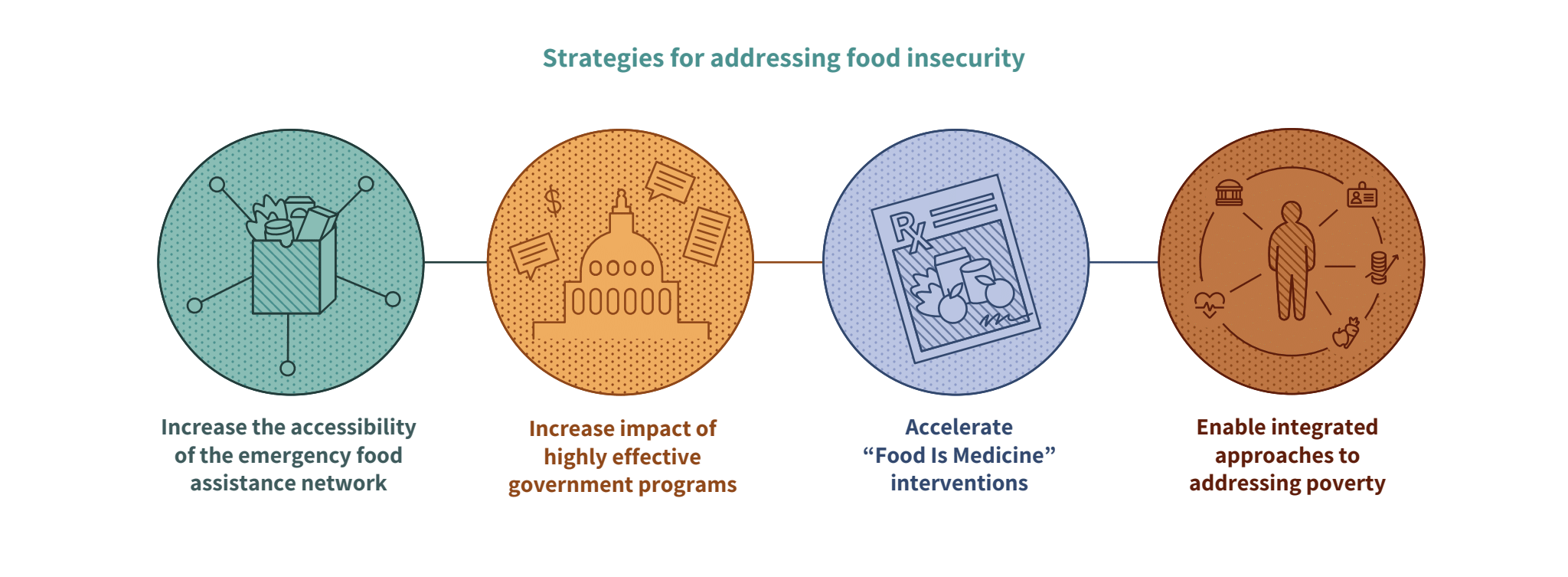The end of the pandemic did not mark the end of staggering levels of food insecurity across the Greater Washington region.
One in three residents – 32% – did not know where their next meal was coming from at some point between May 2022 and April 2023, according to the Capital Area Food Bank’s new Hunger Report. That’s essentially unchanged from the 33% of respondents who reported experiencing food insecurity in the 2022 survey.
In every county across the region, at least 1 in 6 residents reported experiencing food insecurity. The issue remains most severe in Prince George’s County, where nearly 1 in 2 households reported struggling to access enough food at some point during the prior year.
It may be surprising to many people that the rate of food insecurity has barely budged at a time when the coronavirus pandemic has come to an end and the overall economic picture has appeared to improve significantly. But the economic gains have not reached everyone equally, leaving more than 1.2 million people in the region struggling to put food on the table.
The pandemic’s ongoing economic upheaval, the rollback of expanded government assistance programs intended to blunt the pandemic’s negative effects, and soaring rates of inflation were major drivers of food insecurity among residents of our region, according to the survey. Among those facing food insecurity, more than half reported major impacts from all three of these dynamics.
To gather the research that informs Hunger Report 2023, the fourth such study issued by the CAFB, the food bank once again partnered with highly trusted independent social research organization NORC at the University of Chicago to conduct a general population survey of nearly 5,300 residents. It provides a detailed look at who is experiencing food insecurity in the Greater Washington region, how an uneven economic recovery has affected food access, and recommendations that ever sector can take to address these challenges in both the short and longer term.
Demographic insights on those facing food insecurity
What does food insecurity look like across the region? Here’s a snapshot:
- Black and brown households are disproportionately affected: Approximately half of Black and Hispanic respondents screened as food insecure, compared to only 14% of white respondents
- Families with children are more likely to be affected – but rates can differ within households: 42% of food-insecure households include children, compared to the 26% of food-secure households. For many food-insecure households with children, the adults screened as food insecure but the children themselves did not, suggesting adults are prioritizing feeding the children first and – at least some of the time – sacrificing their own food to do so.
- A higher likelihood of diet-related illnesses: Nearly half of the region’s food-insecure population is experiencing at least one diet-related health condition – diabetes, high blood pressure or hypertension, or obesity.
- Nearly equal rates among those who are employed and unemployed: 76% of people facing food insecurity were employed, compared to 73% of those who did not experience food insecurity.
- Occurs in higher-earning households as well: Even among households making $120,000 – the median for the region – food insecurity is affecting 1 in 5 families, reflecting the challenges experienced by families experiencing increasingly high costs of living in the region.
Major drivers of food insecurity
Protracted and uneven economic effects of the pandemic: The Capital Area Food Bank’s 2023 study found that people of color, households with children, and those earning less than the median income all reported much more severe impacts from the pandemic than their respective counterparts.
- Of those who reported that their financial situation was made worse by the pandemic (49% overall), only 12% say their household has recovered financially. Among food insecure respondents, only 3% report having recovered financially, and the majority (68%) say recovery is more than a year off.
- Employment remains lower than it was in January 2020, especially among the region’s lowest earners.
- Those who are working may still be struggling to cover the costs of living. The new study found that while the majority of food-insecure individuals are working, most workers showed signs of underemployment and a desire for greater upward mobility.
The rollback of pandemic-era government assistance programs: The pandemic caused profound economic turmoil, including widespread job loss and unemployment, and the federal government temporarily increased benefits through programs like SNAP to try to stabilize the economy.
The food bank’s survey results make clear the positive impacts of this increase on household budgets and food security for SNAP recipients in our region: 70% of SNAP recipients reported that the increase in benefits caused a major, positive impact on their household’s financial situation.
- When these expanded benefits were rolled back across our region in March, SNAP households suffered: 75% of SNAP recipients reported that the reductions to their benefits had a major impact on their finances.
- Reduction of these benefits led to extreme coping mechanisms among one-third of recipients, including skipping meals, going to free food distributions, cutting back on other bills and expenses, using credit cards to pay for food, and borrowing to make ends meet.
Record-setting levels of inflation: Unsurprisingly, the survey also found that an overwhelming majority of adults said inflation or higher than usual prices for housing, food or groceries, utilities, and other goods or prices had at least a minor impact on their financial situation. Those effects were felt most significantly by those whose budgets were stretched thin even before inflation skyrocketed.
- More than eight in 10 food-insecure adults said inflation or higher prices on food and groceries had a major impact on their financial situation, compared to four in 10 food-secure adults who said the same.
- While higher-than-usual prices for groceries and food had a major impact on 52% of the population, that number increased to 66-67% for Black and Hispanic respondents.
Key Recommendations
Addressing food insecurity and the broad forces that shape it requires both short- and long-term strategies to enable a more equitable economy and pathways to opportunity.
These include:
- Increasing the accessibility of the emergency food assistance network: Amongst those who have experienced food insecurity in the last year, only 54% have gotten free groceries or meals from a food pantry, food bank, church, or other place that helps with free food. This suggests barriers exist to accessing assistance programs, which could be addressed through increased awareness, adjusting hours of operation, more alignment with cultural needs, and alternative delivery models.
- Ensuring the continued impact of highly effective government programs: With the number of struggling individuals and families in our region virtually unchanged since last year, the importance of maintaining and where possible, strengthening remaining support programs has never been higher. The Farm Bill being drafted in Congress should strengthen SNAP, as well as The Emergency Food Assistance Program (TEFAP), which is a critical part of the food bank donation stream. At the state level, bolstering income-based tax credit programs is an effective tool for reducing poverty and food insecurity.
- Accelerating “Food Is Medicine” interventions: Diet can drive the prevention, treatment, and even reversal of many illnesses, and through innovative programs combining food and medical care, there’s an expanding recognition that healthful food is an important part of health care. CAFB is excited to be a part of this critical work through programs like our food pharmacy program at Children’s National Hospital, but creating impact at a meaningful scale will ultimately require changing state and federal reimbursement structures.
- Enabling integrated approaches to addressing poverty: There is growing momentum around approaches to alleviating poverty that assume a continuity of care between different sources of support, including government, human services, healthcare, education, and other social sector actors. This can range from simply co-locating services in one physical location to a more comprehensive case-management-style approach.
Want to dive deeper? Click here to read the full report, and help to spread the word about this year’s findings.


